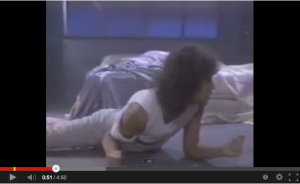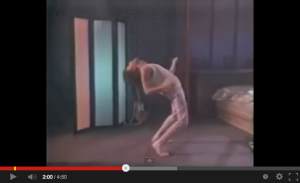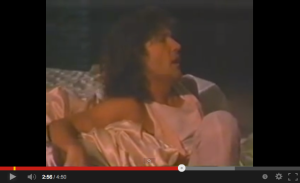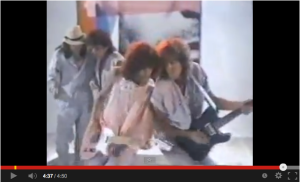Billy Squier
“When the rough cut arrived at Capitol, the immediate consensus was that Billy’s performance was disturbingly effeminate. ‘Is this supposed to be funny?’ ‘Is Billy okay with this?’ He looks totally gay.’ … ‘Maybe we should call it “Cock Me Tonite.”‘”
–Mick Kleber, Capitol Records
“I mean look, Kenny is gay. And this is the way he saw me. He abused my trust, I really feel that…. The video misrepresents who I am as an artist. I was a very good-looking, sexy guy. That certainly didn’t hurt in promoting my music. But in this video I’m kind of a pretty boy. And I’m preening around a room. People said, ‘He’s gay.’ Or, ‘He’s on drugs.’ It was traumatizing to me. I mean, I had nothing against gays. I have a lot of gay friends. But like it or not, it was much more of a sticky issue then.”
–Billy Squier
(Both quotes from I Want My MTV, 252-53)
The song was foolproof, destined to be a classic. What could possibly go wrong with a song as anthemic and sexy and catchy as “Rock Me Tonite”? The title is a perfectly unsubtle in its allusion to sex. The song has a crunchy beat with meaty guitar riffs. It is well performed and builds to a nice climax. It’s nothing profound, just a great bluesy rock song about getting turned on and anticipating sex. Like many great rock songs, it’s a little silly.
Billy Squier was an early 80s version of T-Rex with his slinky moves, big brown curly hair, crotch-tight pants, and songs that contained the barest euphemisms for sex, such as his Classic Rock classic “The Stroke” with its unsubtle chorus “Stroke Me, Stroke Me.” His early videos were simple performance clips with freeze frames and other cheesy effects. As a performer, Squier is charming and charismatic. He’s glam but without the make-up and flamboyant clothing, evoking instead Brando or Dean in his blue collar faded jeans and white T-shirts. There is a dash of Jim Morrison in his look and body movements. In his early videos, he is very sexy.
Billy Squier suffered one of the swiftest and steepest downfalls of the era, and if conventional wisdom is to be believed, it’s all because of the Rock Me Tonite video. No one had any problem with the song, but supposedly the masses of adolescent males rebelled against this video for it being “too gay.” The downfall of his career fits into the same sort of anti-gay backlash that happened at Comiskey Park in 1979 when they blew up all the disco records. Ironically, Squier isn’t even gay. I’m pretty sure he’s had lots of girlfriends. His performance style exuded the androgyny and whiffs of bisexuality of 70s glam bands, but with Squier you sensed it was just performance, Jagger-like in its overstated manner. But this video struck a homophobic nerve in its stylized pink décor, his pouty mannerisms, the way he objectifies himself and rolls around on the floor like a slutty porn star, and perhaps most damning, the video’s complete lack of women despite its sexual vibe.
According to 1980s MTV lore, Squier was headlining a big tour with Def Leppard. During the course of the tour, Rock Me Tonight came out while Def Leppard’s Pyromania videos were getting heavy airplay. The impact of Squier’s video was so negative that they switched spots on the tour, with Squier, the rock veteran, opening up for the newbies. For any rock star, such a demotion is a major humiliation. This switch reinforced the importance of music videos generally but especially in terms of how performers presented themselves sexually on camera. The video’s failure also demonstrated that you didn’t have to be gay to suffer the consequences of 1980s homophobia.
The video is now considered legendary. Marks and Tannenbaum devote a whole chapter to it in I Want My MTV, declaring it “The worst video ever made” and “A whopping, steaming turd.”
Full disclosure: I LOVE THIS VIDEO. I love its sense of abandon, its ecstatic sexual anticipation, and the way he goes crazy lip-synching the song. It was heavily played. I remember watching this video when no one else was home when I was probably 10 or 11 and imitating Squier’s movements in our family room. I’m sure I was not the only proto-gay boy doing so in 1984. I do not think this is a terrible video at all, but a joyful celebration of sleazy desires. And I agree that there are unmistakable gay overtones, which for a homophobic audience would be difficult to sit through over and over. The reason everyone hated this video was the reason I liked it so much. I think it’s Billy Squier’s greatest moment.
After this video, Squier disappeared quickly. He was gone. I think he does retro tours now, and I hope he performs Rock Me Tonight and rolls around the stage in the same masturbatory glory as the video. He was talented and charismatic and his presence on MTV was replaced by bland asexual groups like the Outfield and the Hooters and Bruce Hornsby and the Range. Squier’s sexuality, in contrast, overwhelmed the TV screen. But it proved too much for MTV’s straight male audience. Dick Nixon similarly learned the hard way in 1960 during his famous first debate with JFK that what works on a stage does not necessarily work on television.
The video’s gay vibe is largely the result of its gay director, Kenny Ortega, the same guy who was working with Michael Jackson when he died and directed his This is It movie. (Interestingly he also directed The Tubes’ uber-hetero She’s a Beauty video). Thus a gay director, a gay vibe, a ruined career. Welcome to the 1980s. This was about the same time George Michael began growing his butch stubble and Boy George started thinking about pulling the plug on Culture Club. But is it really that simple? Is the lore to be trusted? It seems improbable that one silly video could so thoroughly wipe out a career. According to Wikipedia, citing a VH1 interview, Squier blames the video for his decline. But I think there is an element of scapegoating in this reasoning.
Rock Me Tonite was Squier’s first video that wasn’t just a straightforward performance clip. It’s setting is a highly stylized bachelor pad style apartment—most of the video takes place here. The opening shot shows shiny satin white sheets bathed in an orange light hinting at sunset or sunrise. Behind his bed is a window with tall buildings in the background, indicating he is in a city. The camera pans along the bed revealing Squier’s nude torso from the chest up. Squier gets up, scratching his billowing brown hair as he cinches his pant-strings. The song is just vocals and keyboards at this point, and he is not lip-synching yet. He continues dressing himself, donning a shirt that evokes The Police’s Synchronicity album in its bright blue, yellow, and red stripes across the middle. It’s a very 80s shirt, carefully torn and stylishly jagged, sleeveless but with part of a sleeve hanging on one side, as though the sleeves had been mostly but not completely ripped off. So edgy! Perhaps the shirt’s New Wavy edge underscored the video’s queer undertone, complementing his usual glammy pouting and hip-shaking. In his earlier videos, Squier dressed more butch and working-class.
The next moment in the video is divine and priceless, and it is the embodiment of why I love this video. Musically, the drums and bass kick in with a measure-long triplet-note fill leading into the first verse. It starts quietly and builds. While this happens, Squier’s whole body starts shaking in perfect rhythm to the notes (almost like he’s rhythmically convulsing) and when the main beat starts, he aggressively snaps his fingers and wildly sways his arms in sync with the beat. Then he lip synchs a salacious “Ya,” the first lip synch of the video, the music and visuals coming together. Steam symbolically rises in the background. This moment sneaks up on you: one second, he’s half asleep putting on his pants, and then suddenly he’s grooving and dancing along with his own music. Let the masturbation begin. After all, he just woke up, and men are usually horny after waking up. As he snaps and shakes, it’s hard not to start snapping and shaking yourself.
I would like to propose one alternate reason why this video failed beyond merely being “too gay:” the video shows Squier’s age in a way that makes the mastubatory sex theme seem creepy and lurid. For example, at second 31, just after the first finger snaps, he looks worn and haggard as he faces the camera. There are lines in his face. He’s in his mid 30s here, but he looks older than that. Def Leppard were all in their 20s, and on MTV, people in their 20s are much sexier than people in their 30s. I don’t think this is a controversial statement, considering that most of MTV’s audience tends to be under 30. So Squier comes off like a dirty old man whether we read the video as queer or not. And the queer overtones, certainly for an 80s audience, compound the creepiness. Onstage, with more physical distance between performer and fans, aging can be better concealed than on the intimacy of television (again, ask Dick Nixon about that).
As the first verse begins, the lighting has shifted from the soft orange of sunrise (or was it sunset?) to the dark blue of twilight, suggesting that time has passed and it is night. Squier lip synchs to the camera while performing his usual stage mannerisms. His apartment is one of those industrial type studio apartments that you always see in 1980s movies, a loft perhaps, with exposed pipes and bricks and direct access to an elevator. He runs his hands through his hair in the reflection of the elevator door as he sings a lyric about hair, then the elevator door opens revealing (what else?) red light and smoke. Suddenly, and jarringly, Squier turns his shoulders and looks right at the camera for the first time in the video. It’s as though he is staring at the viewer, at you, daring you to watch further, aware that he’s being watched and making you aware that he’s aware that you are watching him. He is acknowledging our voyeurism, our spying on him as he plays out his solitary sex fantasy. This direct confrontation makes the video even creepier and sleazier. Again, he looks old and tired as he leers at us.
The video’s pace quickens. After a long lingering shot of his body, Squier suddenly plunges down on the ground and starts slinking across the floor like a snake. Then he flips onto his back, flailing his arms in the air as he sings, a full body shot from above followed by a close-up of his face. There is a lurid freeze frame of him on the floor thrusting his hip in the air provocatively with his crotch in the dead center of frame. Then he’s on his knees moving to the music’s rhythm while tossing a pink shirt in the air as the song’s first chorus commences. There is definitely a burlesque influence in this video as Squier revels in the art of the tease, of intimation and suggestion—not to mention subversion in the queer overtones.
Another amazing moment comes at the end of the first chorus. After skipping around his apartment/studio/loft flailing his arms wildly and air guitaring he then rips the Synchronicity-style shirt in half. The camera freeze-frames on his torso, perfectly synchronized with the final note of the chorus, a simultaneous guitar strum and cymbal crash. The shirt-ripping seems to represent an orgasm after getting so worked up. Premature ejaculation, perhaps? The song has a ways to go. Obviously, he couldn’t control himself.
Round two. As the second verse begins, we see Squier exhale a deep breath as though, indeed, he’d just had an orgasm. But he’s about to get all hot and bothered again. He now dons one of the video’s most notoriously “gay” fashion choices: a little pink tank top over a sleeveless white t-shirt.
If there is a storyline to this video, it is that Billy’s music makes Billy horny. It takes him over and possesses him and turns him into a raging sexual monster that violently rips shirts apart. The idea that music can inspire a person to go crazy and act sexual in private is a common pop culture theme in the era, perhaps most famously depicted in Risky Business when Tom Cruise dances in his underwear to Bob Seger’s Old Time Rock and Roll. But Tom Cruise was 21 at the time, playing a teenager, while Squier is 34. He might as well be 100.
Soon Squier is again engulfed in his music’s groove and returns to his hip-swaying finger-snapping pouty lip-synching ways. At one point he even slides down a pole like pole dancer. His body wails and flails. He looks off into the distance as if he is alone, but we know that he knows that we’re watching him. The choreography is random and jerky, probably improvised or loosely rehearsed. This may have contributed to the video’s failure, because by 1984, choreography tended to be more planned out and elaborate. Squier is not a dancer—his movements are in the tradition of slinky rock star god. But this was the era of Michael Jackson. The dancing had to be sharp. Even poor Pat Benatar had to learn a few dance steps for Love is a Battlefield. Instead of seeing a carefully polished visual accompaniment to Rock Me Tonite, you see an aging man flailing around randomly. His stage schtick works better in the presence of a band and other musicians. Alone in the room, his movements seem exaggerated.
After two choruses of prancing and skipping and head bobbing, he finally collapses on his satin sheet bed and sings the bridge in a state of exhaustion. He is bathed in red light, closing his eyes or looking up at the ceiling or looking directly at us.
As the song builds to the final chorus, he picks up an electric guitar, straps it on and walks to the pink elevator, then holds up the pinkish guitar as though talking to it, and sings the climactic line “come on babe!” Then there is a cut to Squier singing the first line of the chorus while pointing at us. He’s no longer in the apartment, but on a very clichéd stylized music video set: white pedestals for each musician, a white background (like a photo studio), and framed album cover art floating in the air. Squier now wears a silk handkerchief around his neck, like he’s a gay cowboy. I’d imagine the handkerchief was probably the last straw for many heterosexual male viewers.
The queerness continues into this final performance section of the video. There is a lot of male-to-male contact here. Squier bumps up against the drummer in a manner that would be normal in a concert, but in this video, given the queer overtones, just makes him more faggy. The drummer and another band member also bump their asses together, followed by Billy and the guitarist bumping up against each other. None of these musicians are very attractive. They look like they’ve been on tour for too long. Who would want to look at them when you can look at the cute guys in Duran Duran, or even Def Leppard? On MTV, cute is better than ugly, and young is better than old.
For me, the video captures the sleazy joy of sex perfectly, sex as a purely guilty pleasure, something that makes you feel dirty and depraved. This was definitely how I felt every time I jerked off thinking about boys instead of girls. Gay boys like me were taught to feel shame about our sexuality, to suppress it, ignore it, fear it—not just gayness, but any sexuality that was not quite the hegemonic heterosexual sex. Given the strict norms of the 1980s, even to celebrate masturbatory pleasure represented a manifestation of queer desire (I was told bluntly by a Little League coach once that masturbation was horrible and that only “fags” did it). Thus, I revel in the video’s joyful sexual abandon, its aggressive pleasure in deviant sexual pleasure, something of particular interest to most adolescent boys but especially adolescent gay boys.
Probably the greatest offense of this video from the perspective of the heterosexist cultural assumptions of the Reagan Era was its lack of women. Since there are no women, there is no moment when Squier can reassure his audience that, indeed, he’s into women. This was the standard practice: Elton John slapping the girl’s ass in I’m Still Standing, George Michael’s sexy girlfriends, something to throw people off the trail. Since Squier isn’t gay, perhaps he felt no need to do so. The way the video unfolds, we might suspect that he is fantasizing about men because of how much he turns himself on. The video never suggests otherwise. Or perhaps it was a conscious decision of the gay director to present Squier as deliberately sexually androgynous in the T Rex tradition. This may have seemed like a clever idea, but it was naïve in terms of how MTV worked. Think about the hair metal videos that were so popular from 1985 to 1989: these videos abundantly appropriated gay, trans, and queer imagery (hair, make-up, jewelry, lace, etc.), but always threw in a gaggle of slutty girls to reassure its adolescent audience “that’s just our outrageous style meant to upset square uptight people like your parents, but despite how faggy we look we’re totally straight and into girls.” And most were. I bet if Squier had thrown in a hot female model into the video, no one would have complained. It would have given the straight boys something to watch besides Squier’s fading beauty and spastic movements.
The posted Youtube comments for this video are very interesting. They debate whether the video really killed his career or not, and whether the video deserves its notorious reputation or not. Some think Squier’s songs were getting weaker, others attribute age, wear, and tear to his sudden decline. It is clear from looking at these comments that I am not the only person who immensely enjoys this video. But the typical comment is that it’s a super gay video, it’s a terrible video, and no wonder it ruined Squier’s career. The video’s gayness is certainly its most remarked feature. This comment speaks for many others: “Went from a hard rocker to a George Michael wanna be……”
The video became a focal point of anti-gay hostility, much like disco had a few years earlier. Ultimately, it was not the gayness of this video that killed Squier’s career, but rather the era’s homophobia.




















Very well written and I agree with your conclusions, but you might have another look at the ‘pink shirt’ Squier throws in the air in the first chorus. It’s got spaghetti straps and is made of very light cloth as it floats in the air. It’s obviously not a men’s shirt but a woman’s satin neglige. So there is a female hint in the video after all. It explains everything: Squier awakes and finds himself alone because his girlfriend sneaked out earlier, leaving nothing but her underwear! No wonder he got frustrated!
LikeLike
Thank you for your comment! Very interesting insight, I appreciate it.
LikeLike
I’m confused. I just seen this video for the first time in quite awhile. Seriously don’t remember having a major opinion on it way back in middle school when this came out. If there was anything ‘gay’ about it, so what? But the thing is, after seeing this for the first time in eons as an adult, I don’t see anything really ‘gay’ about it. My only guess is that Billy’s career, as very credibly ’70s-like classic-rock-like it was, was fading with the flamboyant ’80s like it or not. “Rock Me Tonight” had enough synth to it to make it not so hard-core, down-to-earth rock. Did this video ‘ruin’ his career? Likely not. Correct me if wrong.
LikeLike